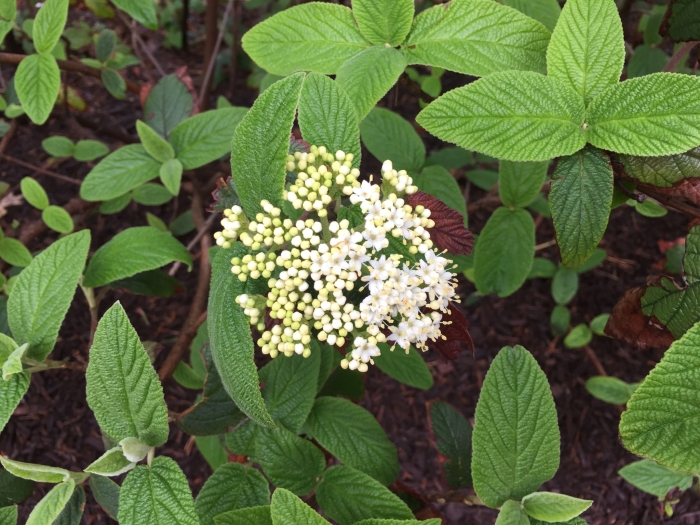Lantanaphyllum Viburnum
(Viburnum ×rhytidophylloides)
Lantanaphyllum Viburnum (Viburnum ×rhytidophylloides)
/
/

© Judy Gallagher
CC BY-SA 4.0
Image By:
© Judy Gallagher
Recorded By:
Copyright:
CC BY-SA 4.0
Copyright Notice:
Photo by: © Judy Gallagher | License Type: CC BY-SA 4.0 | License URL: http://creativecommons.org/licenses/by-sa/4.0/ | Uploader: judygva | Publisher: iNaturalist |
















Estimated Native Range
Summary
Viburnum ×rhytidophylloides, commonly known as Lantanaphyllum Viburnum or Leatherleaf Viburnum, is a semi-evergreen perennial shrub that is an artificial hybrid resulting from the cross between Viburnum rhytidophyllum and Viburnum lantana. It is not naturally occurring but has been bred to combine the desirable traits of both parent species. This shrub typically grows at a moderate rate to a height and width of 6-10 feet (1.8-3 meters). It features wrinkled, dark green leaves and bears clusters of creamy white flowers in the spring, which are quite showy and attract pollinators. The flowers may be followed by red berries that mature to black, providing interest in the landscape and food for birds.
Lantanaphyllum Viburnum is valued for its textured foliage, spring flowers, and berries. It is used in cultivation for hedges, screens, or as a specimen plant in residential gardens and public landscapes. It is adaptable to a range of soil types, including clay, loam, or sandy soils, and can tolerate both fast and slow drainage. While it prefers medium amounts of water, it is relatively drought-tolerant once established. It thrives in full sun to part shade and benefits from mulching to maintain soil moisture. Pruning is recommended to shape the plant and encourage denser growth. It is generally disease-resistant but can be susceptible to leaf spot and powdery mildew.CC BY-SA 4.0
Lantanaphyllum Viburnum is valued for its textured foliage, spring flowers, and berries. It is used in cultivation for hedges, screens, or as a specimen plant in residential gardens and public landscapes. It is adaptable to a range of soil types, including clay, loam, or sandy soils, and can tolerate both fast and slow drainage. While it prefers medium amounts of water, it is relatively drought-tolerant once established. It thrives in full sun to part shade and benefits from mulching to maintain soil moisture. Pruning is recommended to shape the plant and encourage denser growth. It is generally disease-resistant but can be susceptible to leaf spot and powdery mildew.CC BY-SA 4.0
Plant Description
- Plant Type: Shrub
- Height: 6-10 feet
- Width: 6-10 feet
- Growth Rate: Moderate
- Flower Color: White
- Flowering Season: Spring
- Leaf Retention: Evergreen
Growth Requirements
- Sun: Full Sun, Part Shade
- Water: Medium
- Drainage: Fast, Medium, Slow
Common Uses
Bird Garden, Border Plant, Hedges, Low Maintenance, Showy Flowers, Street Planting
Natural Habitat
Artificial hybrid, semi-evergreen, moderate growth rate, creamy white spring flowers, red to black berries, adaptable to various soils, drought-tolerant once established, susceptible to leaf spot and powdery mildew
Other Names
Common Names: Leatherleaf Viburnum
Scientific Names: Viburnum ×rhytidophylloides
GBIF Accepted Name: